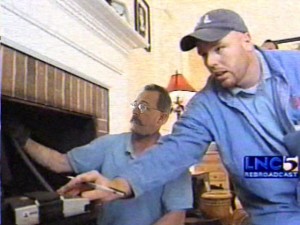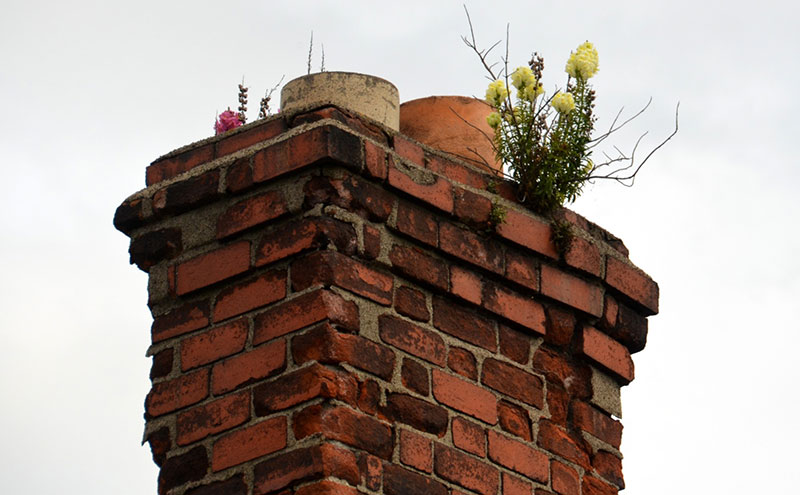 Owning a fireplace is a great way to relax and enjoy yourself with friends and family, but it also comes with a lot of responsibility. If you’re the owner of a home with a fireplace, you probably don’t think about the importance of having an inspection and cleaning out your chimney regularly. Most homeowners are happy to go on using their fireplace not realizing how damaging failure to clean out the chimney can be. However, failure to maintain the chimney can lead to debris build-up, obstructions in your flue, and structural damages. When your chimney gets buildups of soot and creosote, you can actually create a fire hazard.
Owning a fireplace is a great way to relax and enjoy yourself with friends and family, but it also comes with a lot of responsibility. If you’re the owner of a home with a fireplace, you probably don’t think about the importance of having an inspection and cleaning out your chimney regularly. Most homeowners are happy to go on using their fireplace not realizing how damaging failure to clean out the chimney can be. However, failure to maintain the chimney can lead to debris build-up, obstructions in your flue, and structural damages. When your chimney gets buildups of soot and creosote, you can actually create a fire hazard.
Rather than wait until it’s too late, employ a certified chimney technician from Black Goose and clear out the inside of your chimney so that your fireplace can function at its best. Bringing in a professional, certified chimney sweep can help you get rid of potential fire hazards in the home and keep you safer. Let’s take a look at just what is a chimney sweeping and why it matters.
What Is a Chimney Sweeping?
A chimney sweeping is just what it sounds like – someone comes into your home and sweeps the soot and debris out of your chimney. Chimney technicians are specially trained to clean out every area of the chimney including the flues, smoke chamber, firebox, and more. We at Black Goose also have specialized knowledge of fire safety and codes and are able to conduct in-depth inspections of your chimney.
Whether you have a gas fireplace, a wood-burning fireplace, or a different type of fireplace, it’s important to bring in a certified professional to inspect and sweep out your chimneys. That way you keep the home and the people in it safer.
What Part of the Chimney Requires Service?
Sweeping a chimney doesn’t just mean cleaning out the fireplace and calling it a day. In fact, there are many different parts of the chimney that should be regularly swept out, including:
- The chimney cap
- The chimney flues
- The smoke chamber and smoke shelf
- The throat
- The firebox
All of these parts of the chimney get swept out during your servicing, leaving you with a cleaner and clear chimney. The inspection also includes checking for deterioration of the caulking, flashing, and mortar work – especially at the top of the chimney.
How Did Chimney Sweeping Originate?
Chimney sweeping has been around since the 13th century, but it didn’t really catch on for another few hundred years. This is where the name of our business came from; the old saying “The blacker the goose the cleaner the chimney!” In fact in the past, many people didn’t understand the importance of sweeping out the chimney to prevent fires, and with thatched roofs being the norm, house fires were fairly common.
Around the 16th century, people began realizing the importance of cleaning debris out of the chimney in order to prevent fires in the home. By the 17th century, having a chimney sweep was the best way to keep the air in the home clean. People understood that soot buildup not only created fires but led to toxic fumes in the home. Over the years, tools and methods for chimney sweeping improved. Today, we have the high-tech brushes and tools needed to provide exceptional cleaning!
How Is the Chimney swept?

Every chimney technician works a little bit differently, but most chimney technicians follow a standard cleaning process. Let’s dive into exactly what it means to hire a Black Goose chimney technician to sweep out your chimneys and get your fireplaces functioning properly.
Step One: Preparing The Space
To get started with, your technician will come in and place drop cloths in the area in front of the fireplace.
Step Two: Preparing The Vacuum
After the drop cloths are in place in your home, our technician will set up an industrial level vacuum near the fireplace. The vacuum will be switched on and will stay running throughout the entire chimney sweeping process to help suck up any debris flushed out of the chimney during the sweeping.
The vacuum isn’t actually used for cleaning, but serves more as a preventative measure to keep dust and soot out of your home and to pick up loose materials that are flushed out of the chimney.
Step Three: Cleaning The Flues
The next part of the cleaning process is to clear out the flues on your chimney. Your technician will run special brushes on long rods up and down the flue. The brushing will remove creosote and soot deposits. The vacuum running keeps the home clean and stops dust from getting into the rooms of your house.
Step Four: Inspecting The Flue
Now that your technician has cleaned out the flues, it’s time for him or her to do a visual inspection of the chimney. Your chimney sweep will shine a bright light in the chimney to check on the work and run a visual inspection on the cleanliness of the chimney.
Step Five: Continuing The Cleaning
Once the visual inspection is finished the technician will begin working at the base of the fireplace. Small brushes are run up into the smoke chamber via the damper so that soot and creosote can be cleaned out of the smoke shelf. The debris that’s removed is either scooped or vacuumed out of the opening.
Step Six: Wrapping Up
The chimney sweep process is wrapped up by turning off the vacuum, clearing up the drop cloths, and loading all the equipment back onto the work truck. The chimney technician will provide you with an evaluation and inspection report so that you have a better understanding of the condition of the chimney and how your venting system works as a whole.
Why Are Chimney Inspections and Sweeps Important?
There are plenty of reasons why you need a chimney inspection and sweep, but the main reason is to prevent fires. When the fireplace isn’t regularly serviced, a buildup of soot and creosote can develop in the flue. Soot and creosote are made up of between 80 and 90 percent carbon, with the remaining 10 to 20 percent being hydrogen. Soot is created after burning wood that’s moist, wood with an insufficient oxygen supply, or during incorrect burning. All wood produces creosote when burned.
All of these issues can lead to creosote and soot buildup in the chimney, which can, in turn, lead to fire hazards and potential safety threats. When you hire a chimney sweep, you help prevent these types of issues. The chimney technician has special fire prevention skills that they use throughout the cleaning process. Plus, the chimney technician can help to advise you about how to properly burn wood in your fireplace.
It’s also important to clean the chimney to ensure that you don’t start creosote fires and to make sure you’re burning correctly. Fireplaces that have a lot of soot are releasing many gases and causing environmental damage. It’s important to reduce the soot and creosote so that you can protect the environment, the home, and your family. Hiring a chimney technician to sweep the chimney ensures that you’re taking care of this issue in the most effective way possible.
What Happens if I Don’t Sweep My Chimney Regularly?
You can’t just get the chimney swept once and leave it at that. In fact, you’ll need to periodically sweep out the chimney to prevent damage and avoid the creosote fires that were mentioned above. The National Fire Protection Association (NPFA.org) publishes the national standards for fireplaces and chimneys. This standard requires annual inspections and sweeping as needed.
The frequency you’ll need to sweep the chimney depends on how often you use your fireplace, what kind of fireplace you have, and what type of burning pattern you follow. Understanding these factors can help you get a better idea of how often you’ll need to sweep the chimney.
Can I Clean My Chimney By Myself?
While cleaning out the chimney on your own might seem like a great idea, the truth is that there are many risks associated with this. DIYing a chimney cleaning could mean that you miss certain soot buildups in the flues or on the smoke shelf.
Without the necessary equipment and training, you run the risk of inadvertently leaving fire hazards in the chimney. To make sure your home is truly protected, it’s always best to hire a professional like Black Goose.
What Should I Do Before Scheduling a Chimney Sweep?
To get ready for the chimney sweeping, you’ll need to remove any obstructions or obstacles that could prevent the chimney technician from being able to get in and do his or her job. They will need a clear path to an open spot in front of the fireplace.
During the sweeping process and afterward, you’ll want to take the time to ask your chimney technician any questions you have about fire safety and preventative measures. Your chimney technician will provide you with an audit once your cleaning is over and will let you know about any defects or areas of concern that were uncovered during the sweeping process.
Your home is important, as are the people in it. Keep your loved ones safe from fire hazards and schedule a chimney inspection and sweeping with Black Goose today! We’re here to answer your phone calls and get you taken care of!
